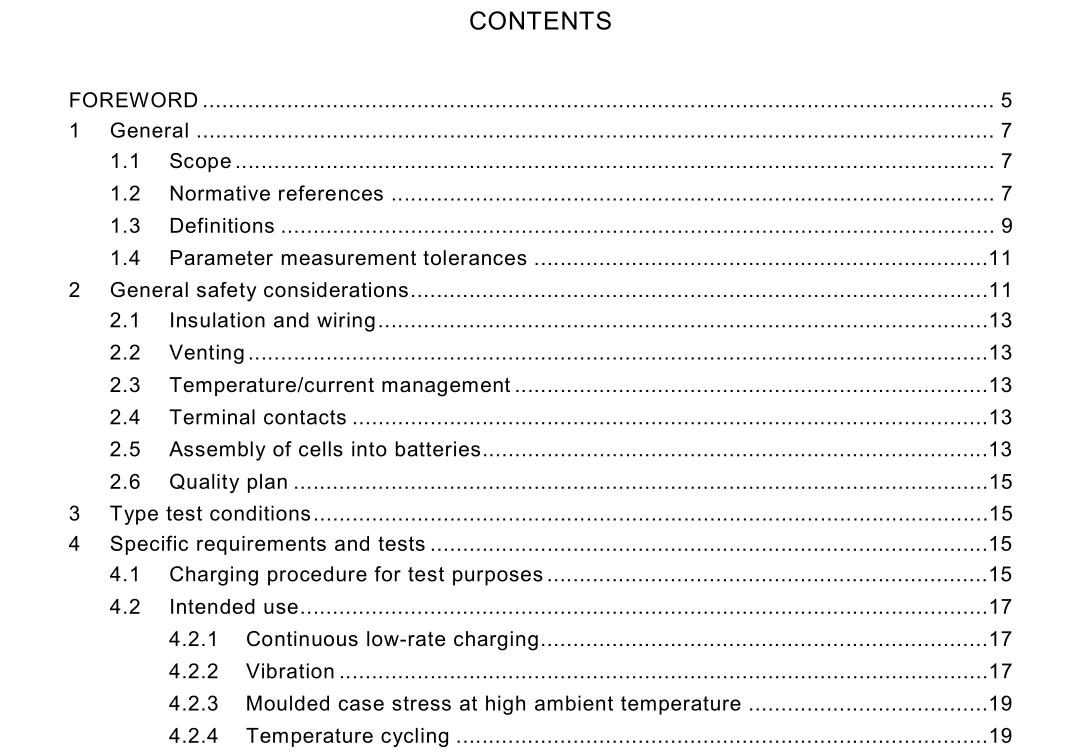IEC 62133 pdf download

IEC 62133 pdf download.Secondary cells and batteries containing alkaline or other non-acid electrolytes
1 General
1.1 Scope This International Standard specifies requirements and tests for the safe operation of portable sealed secondary cells and batteries (other than button) containing alkaline or other non-acid electrolyte, under intended use and reasonably foreseeable misuse. 1.2 Normative references The following referenced documents are indispensable for the application of this document. For dated references, only the edition cited applies. For undated references, the latest edition of the referenced document (including any amendments) applies. IEC 60050-486, International Electrotechnical Vocabulary – Chapter 486: Secondary cells and batteries IEC 60051 (all parts), Direct acting indicating analogue electrical measuring instruments and their accessories IEC 60285, Alkaline secondary cells and batteries – Sealed nickel-cadmium cylindrical rechargeable single cells IEC 60485, Digital electronic d.c. voltmeters and d.c. electronic analogue-to-digital converters IEC 61 436, Secondary cells and batteries containing alkaline or other non-acid electrolytes – Sealed nickel-metal hydride rechargeable single cells IEC 61 438, Possible safety and health hazards in the use of alkaline secondary cells and batteries – Guide to equipment manufacturers and users IEC 61 440, Secondary cells and batteries containing alkaline or other non-acid electrolytes – Sealed nickel-cadmium small prismatic rechargeable single cells IEC 61 951 -1 , Secondary cells and batteries containing alkaline or other non-acid electrolytes – Portable sealed rechargeable single cells – Part 1: Nickel-cadmium IEC 61 951 -2, Secondary cells and batteries containing alkaline or other non-acid electrolytes – Portable sealed rechargeable single cells – Part 2: Nickel-metal hydride IEC 61 960, Secondary cells and batteries containing alkaline or other non-acid electrolytes – Secondary lithium cells and batteries for portable applications
1.3 Definitions
For the purpose of this international standard, the definitions contained in IEC 60050-486 and ISO/IEC Guide 51 as well as the following definitions apply. 1.3.1 safety freedom from unacceptable risk 1.3.2 risk a combination of the probability of occurrence of harm and the severity of that harm 1.3.3 harm physical injury or damage to the health of people or damage to property or to the environment 1.3.4 hazard potential source of harm 1.3.5 intended use use of a product, process or service in accordance with specifications, instructions and information provided by the supplier 1.3.6 reasonably foreseeable misuse use of a product, process or service in a way which is not intended by the supplier, but which may result from readily predictable human behaviour 1.3.7 secondary cell basic manufactured unit providing a source of electrical energy by direct conversion of chemical energy, that consists of electrodes, separators, electrolyte, container and terminals, and that is designed to be charged electrically 1.3.8 secondary battery assembly of secondary cell(s) ready for use as a source of electrical energy characterized by its voltage, size, terminal arrangement, capacity and rate capability 1.3.9 leakage visible escape of liquid electrolyte 1.3.1 0 venting release of excessive internal pressure from a cell/battery in a manner intended by design to preclude rupture or explosion 1.3.1 1 rupture mechanical failure of a cell container or battery case induced by an internal or external cause, resulting in exposure or spillage but not ejection of materials.
2 General safety considerations
The safety of secondary cells and batteries requires the consideration of two sets of applied conditions: a) intended use; b) reasonably foreseeable misuse. Cells and batteries shall be so designed and constructed that they are safe under conditions of both intended use and reasonably foreseeable misuse. It is expected that cells or batteries subjected to misuse may fail to function following such experience. They shall not however present significant hazards. It may also be expected that cells and batteries subjected to intended use shall not only be safe but shall continue to be functional in all respects.2.1 Insulation and wiring The insulation resistance between the positive terminal and externally exposed metal surfaces of the battery excluding electrical contact surfaces shall be not less than 5 MΩ at 500 V d.c. Internal wiring and its insulation shall be sufficient to withstand the maximum anticipated current, voltage and temperature requirements. The orientation of wiring shall be such that adequate clearances and creepage distances are maintained between connectors. The mechanical integrity of internal connections shall be sufficient to accommodate conditions of reasonably foreseeable misuse. 2.2 Venting Battery cases and cells shall incorporate a pressure relief mechanism or shall be so constructed that they will relieve excessive internal pressure at a value and rate that will preclude rupture, explosion and self-ignition. If encapsulation is used to support cells within an outer case, the type of encapsulant and the method of encapsulation shall neither cause the battery to overheat during normal operation nor inhibit pressure relief.









